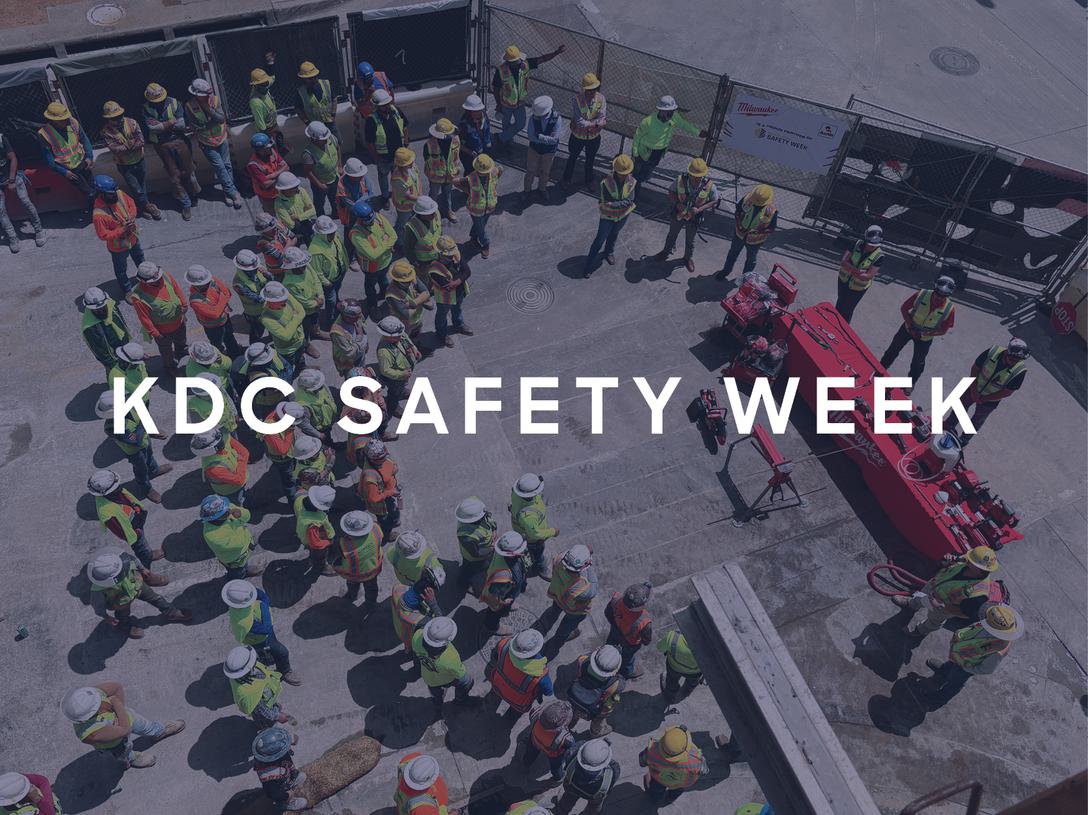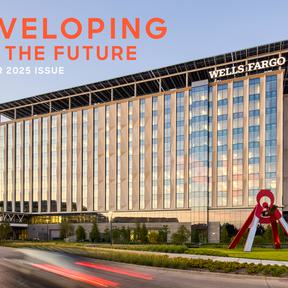
CHOOSING SAFETY: A PRIMER ON JOB SITE WORKER WELL-BEING
05/08/25 | Thought Leadership
Construction sites are high-risk environments. Unfortunately, this is the nature of the work. However, just because these places are risky doesn’t mean they can’t be made safer.
KDC takes this to heart, creating environments to empower general contractors and their safety efforts. As a result, the contractors with whom we partner with on KDC-developed projects are able to make decisions and implement plans to help minimize on-site hazards for workers.
A great example of KDC’s efforts can be found within our current project, the Bank of America Tower at Parkside, located in Dallas’ Uptown submarket. This 500,000-square-foot project is a microcosm of how KDC plans for and supports safety initiatives.
What is Safety?
Safety doesn’t mean risk-free. Rather, safety recognizes and mitigates hazards to protect workers. KDC defines safety as:
- Doing the right thing even when no one is looking.
- Ensuring that everyone goes home at the end of each day, in the same condition they arrived.
In 2008, then KDC Executive Vice President Murray Newton created and distributed a mandate that directed the company to take “decisive steps to distinguish ourselves in the marketplace as a leader in Project Safety matters” by:
- Implementing construction safety as part of the KDC corporate culture.
- Understanding the moral and financial benefits of public safety.
- Associating and working with contractors and subcontractors who “ingrain safety as a part of the company culture.”
Over the years, KDC has added to Newton’s ideas the concept of being proactive. Specifically, we work with contractors on preventative measures rather than dealing with risks and hazards after they occur. This involves using the “Three Es:” Establishing a plan, Emphasizing worker well-being, and Ensuring ongoing communications.
Establishing a Plan
The first step in safety rests with a plan. That plan will change throughout the process. However, it offers clarity, consistency and direction from dirt work to the certificate of occupancy.
The Parkside plan included the following aspects.
Logistics Knowledge
All plans should focus on logistics and infrastructure to protect the areas and people near construction activities. Parkside is a vertical build in a heavily trafficked urban area. As such, the logistics plan considers:
- Automobile and bicycle traffic flow
- Pedestrian movements
- Community impacts (including service disruption and noise)
This and other data support on-site contractors in making informed decisions about when certain roads and sidewalks should be closed and how to respond to questions from pedestrians and neighbors.
Another important issue is the understanding that everything—including construction plans—changes. Logistics for a construction job launched during the summer months, when school is out, will change when classes start up again. More cars, people and buses are around, changing the nature of street closures and traffic awareness.
Understanding Hazards
One major issue concerning construction-site safety involves ongoing hazards. On-site debris could generate trips and falls. Contact with energized parts might mean electrocution. A misplaced tool that falls could break bones.
Construction-site safety relies on the “OSHA’s Focus Four” as a foundation with the goal of reducing:
- Falls
- Struck-by occurrences
- Caught-in or caught-between incidents
- Electrocution
However, Focus Four is a minimal directive. Effective safety plans must consider ALL potential hazards and risks, including those unique to the job site.
For example, Parkside is 30 stories above street level. This means moving heavy materials—think structural steel, unitized curtainwall panels and precast panels—to the upper floors. Equipment failure or worker inattention can pose threats to contractors, drivers, pedestrians and neighboring buildings.
A well-thought-out plan can mitigate risks. Such a framework supports street and sidewalk closures, heavy equipment usage and worker allocation to protect life and property in the area.
Planning should also go beyond direct construction dangers. Spring in North Texas guarantees a severe storm or two; the Parkside plan outlines what to do if lightning strikes, as well as if high winds, hail or tornadoes occur.
Additionally, DFW's hot summers are brutal; heat exhaustion and heat stroke are real threats. The Parkside plan requires workers to take frequent breaks and drink plenty of water. Additionally, KONA Ice food trucks are on-site at various times, providing construction workers cold treats.
Emphasizing Worker Well-Being
Construction worker well-being focuses on physical and emotional health. One facet of that is helping those construction workers be aware of hazards that might impact their health. This is where situational awareness comes in.
Situational awareness is key to protecting job-site workers and helping those connected to the task understand their environment and possible hazards. When applied correctly, situational awareness helps forecast outcomes, allowing supervisors to take preventative measures that improve safety.
However, situational awareness also requires empowering workers to speak up and act without fear of retribution. Anyone working on a construction site who sees something out of place must feel free to tell supervisors.
Other steps to help enhance worker well-being include:
The Daily Walkthrough
Before activities start, supervisors must walk the site daily to identify and address potential problems. Addressing issues at the start can be vital in reducing workplace accidents.
Scheduled Meetings
Planning regular daily or weekly meetings (with mandated attendance) helps everyone remain safety aware by discussing possible hazardous issues and collecting solutions. Such meetings also ensure that all involved with the project remain informed about timelines and progress.
Worker Experience
Workers on a site are either newcomers (with little to no experience) or veterans (who have been around for a while). Newcomers require safety training and should be paired with veterans. At the same time, veterans could become complacent. To counteract this, refresher training and audits can help reduce risks.
Ensuring Communication
Frequent communication is a must at job sites, especially when it comes to reducing risks and accidents. However, there is more to communication than talking up safety issues. The plan should include tasks like:
Knowing Everyone
Communicating with every contractor and subcontractor can help decrease job-site hazards. KDC supervisors make it a point to engage frequently with all job participants. Even a friendly greeting and a couple of questions about the family or other matters show workers that the company supports them and works in their best interests.
Changing it Up
Multiple talks, posters and emails with safety reminders can be used. However, reiterating the same messages in the same ways ensures workers will tune them out. Changing the presentation can help keep the message fresh and relevant. During presentations, KDC supervisors rely on the slow clap—also known as the “Viking clap”—to snap people out of a mindless drift. This action encourages others to clap along, which perks them up and helps prepare them to listen.
Presenting Rewards and Accolades
Individuals like to be recognized. Thanking workers for safety actions during meetings or rewarding them for their efforts can encourage them to do more of the same. KDC regularly hosts Safety Lunches that recognize workers who have gone the extra mile in their quest for hazard protection.
Construction Safety: An Imperative
A successful construction job involves more than putting together steel and concrete. It also involves proactively mitigating risks and increasing safety.
Understanding logistics, paying attention to worker well-being and protection, and ensuring frequent and motivating communications are essential components of a well-thought-out safety strategy. Distributing the plan and making sure everyone understands it can reduce on-the-job injuries and deaths.
When general contractors and construction workers are empowered to prioritize safety issues, they feel valued. The more valued they feel, the more likely they are to be aware, engaged, and productive in their tasks. Morale increases, turnover and absenteeism decrease, and the job is completed on time and within budget.





